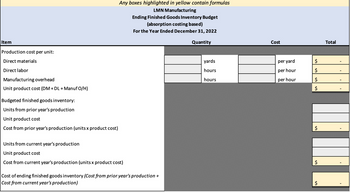Item Production cost per unit: Direct materials Direct labor Manufacturing overhead Unit product cost (DM + DL + Manuf O/H) Budgeted finished goods inventory: Units from prior year's production Unit product cost Cost from prior year's production (units x product cost) Any boxes highlighted in yellow contain formulas LMN Manufacturing Ending Finished Goods Inventory Budget (absorption costing based) For the Year Ended December 31, 2022 Quantity Units from current year's production Unit product cost Cost from current year's production (units x product cost) Cost of ending finished goods inventory (Cost from prior year's production + Cost from current year's production) yards hours hours Cost per yard per hour per hour $ $ $ $ $ $ $ Total
Oh no! Our experts couldn't answer your question.
Don't worry! We won't leave you hanging. Plus, we're giving you back one question for the inconvenience.
Balance Sheet
December 31, 2021
Current Assets:
Cash 46,200
Accounts Receivable (net) 260,000
Raw materials inventory (4,500 yards) 11,250
Finished goods inventory (1,500 units) 32,250
Total current assets 349,700
Plant and equipment:
Buildings and equipment 900,000
Accumulated depreciation (292,000)
Plant and equipment, net 608,000
Total Assets 957,700
Liabilities and Stockholders' Equity
Current liabilities: 158,000
Accounts Payable
Stockholders' equity:
Common stock 419,800
Retained earnings 379,900
Total stockholders; equty 799,700
Total liabilities and stockholder's equity 957,700
Additional Information
The company's chief financial officer (CFO), in consultation with various managers across the organization has developed the following set of assumptions to help create the 2022 budget:
1 The budgeted unit sales are 12,000 units, 37,000 units, 15,000 units and 25,000 units for quarters 1-4, respectively. Notice that the company experiences peak sales in the second and fourth quarters. The budgeted selling price for the year is $33 per unit. The budgeted unit sales for the first quarter of 2023 is 13,000 units
2 All sales are on credit. Uncollectible accounts are negligible and can be ignored. Seventy-five percent of all credit sales are collected in the quarter of the sale and 25% are collected in the subsequent quarter.
3 Each quaarter's ending finished goods inventory should equal 15% of the next quarter's unit sales
4 Each unit of finished goods requires 3.5 yards of raw material that costs $3.25 per yard. Each quarter's ending raw materials inventory should equal 10% of the next quarter's production needs. The estimated ending raw materials inventory on Dececember 31, 2022 is 5,000 yards
5 Seventy-five percent of each quarter's purchases are paid for in the quarter of purchase. The remaining 25% of each quarter's purchases are paid in the following quarter
6 Direct laborers are paid $20 an hour and each unit of finished goods requires 0.25 direct labor-hours to complete. All direct labor costs are paid in the quarter incurred
7 The budgeted variable manufacturing overhead per direct labor-hour is $3.25. The quarterly fixed manufacturing overhead is $150,000 including $20,000 of depreciation on equipment. The number of direct labor-hours is used as the allocation base for the budgeted plantwide overhead rate. All overhead costs (excluding depreciation) are paid in the quarter incurred.
8 The budgeted variable selling and administrative expense is $1.25 per unit sold. The fixed selling and administrative expenses per quarter include advertising ($20,000), executive salaries ($64,000), insurance ($13,000) property tax ($8,000) and depreciation expense ($8,000). All selling and administrative expenses (excluding depreciation) are paid in the quarter incurred.
9 The company plans to maintain a minimum cash balance at the end of each quarter of $40,000. Assume that any borrowings take place on the first day of the quarter. To the extent possible, the company will repay principal and interest on any borrowings on the last day of the fourth quarter. The company's lender imposed a simple interest rate of 5% per quarter on any borrowings.
10 Dividends of $15,000 will be declared and paid in each quarter
11 The company uses a last-in, first-out (LIFO) inventory flow assumption. This means that the most recently purchased raw materials are the "first-out" to use in production and most recently completed finished goods are the "first-out" to customers.
Please determine the following;
Ending finished goods inventory budget at December 31, 2022










